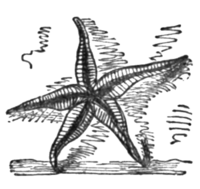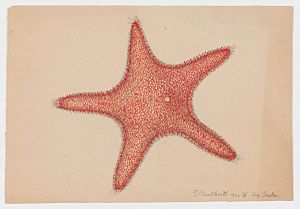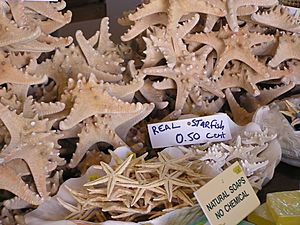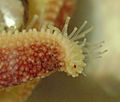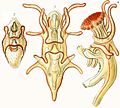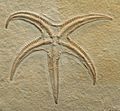Starfish facts for kids
Starfish, also known as sea stars, are amazing sea creatures called Echinoderms. They live on the ocean floor, from shallow areas near the coast to very deep waters. Some even live in the intertidal zone, which is the area between where the water is at its lowest and highest levels during the tides.
Most starfish have five arms, but some can have many more! The biggest starfish is the Sunflower sea star, which can grow to be about a metre wide. That's as big as a small child! Starfish are invertebrates, meaning they don't have a backbone. But they do have a special kind of internal skeleton made of calcium carbonate plates. These plates form spines and bumps on their bodies.
Starfish have a simple nervous system but no brain. They also don't have blood. Instead, they use sea water to move nutrients and other things around their bodies. There are over 1,500 different types of sea stars in the world. Most of them are predators, meaning they hunt and eat other animals. They often eat mussels, clams, and other shellfish. Sometimes, they even catch small fish.
Contents
How Starfish Are Shaped
Most starfish have five arms, which are also called rays. These rays spread out from a central circle, like the spokes of a wheel. If a starfish has more than five rays, it usually has them in groups of five. So, you might see a starfish with 10, 15, 20, or even 30 rays! This five-part shape is called pentameral symmetry.
Starfish Skeleton and Protection
The skeleton of a starfish helps protect it from other animals that might want to eat it. Some starfish have very strong, hard skeletons that offer great protection. This makes them tough to eat! However, a very stiff skeleton can make it harder for the starfish to move and eat certain foods.
Many starfish need to be flexible to eat their prey, especially shellfish. Starfish that are not as heavily protected might live in places where there are fewer predators. Those with strong skeletons can live in more competitive areas. Even with a firm body, many starfish can still bend their bodies and arms quite a bit.
How Starfish Find Food
Starfish use their senses of touch and sight to find their way and hunt for food. They have five simple 'eyes' – light-sensitive spots – one at the end of each arm. These eyes and their special tube feet are connected to nerve fibres, making these animals more complex than they might seem.
Amazing Tube Feet
Long ago, starfish used to filter tiny bits of food from the water. But over time, they changed and became skilled predators, especially of shellfish like brachiopods and bivalves. They can also eat small crustacea and fish.
Their tube feet developed suckers, which probably first helped them move around better. Later, these suckers became super useful for opening the shells of their prey. It's thought that these suckered tube feet might not have existed in ancient starfish from the Palaeozoic era.
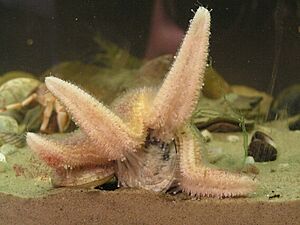
How Starfish Eat Shellfish
The shells of clams and mussels are held tightly closed by strong muscles. A starfish will grab onto the shell with its tube feet on both sides and pull steadily. Starfish have strong muscles and a special hydraulic system that lets them pull for much longer than a clam's muscles can hold.
It usually takes about ten minutes for the starfish to pull the shell open just a tiny bit. Then, the starfish does something amazing: it slips its stomach outside its body and into the shell! Its stomach can fit through a gap as small as 0.1 millimetres. The starfish then digests the mollusc inside its own shell, absorbing all the nutrients. This digestion process takes longer than opening the shell, sometimes a couple of days.
Some starfish species simply swallow their prey whole, shell and all. They digest the contents inside their stomach and then push out the empty shell later.
The ability of starfish to eat shellfish like this developed during the Mesozoic Era, especially in the Jurassic and Cretaceous periods. This was part of a big change in ocean life, where shellfish that were not well-protected or couldn't move fast disappeared, and those with stronger shells or better mobility thrived.
Starfish Regeneration
Starfish are famous for their incredible ability to regenerate, which means growing back lost body parts. They are much better at regeneration than most other creatures. If a starfish loses an arm, it can grow a new one. Even more amazing, if a torn-off arm has a small piece of the central body disk still attached, that single arm can grow into a whole new starfish!
Because starfish enjoy eating clams and oysters, fishermen who collect shellfish have tried for years to get rid of them. In the past, some fishermen would catch starfish, cut them in half, and throw them back into the ocean. But because starfish can regenerate, this actually made the problem worse by increasing the number of starfish! Each half could potentially grow into a new starfish.
Starfish and People
Starfish in Science
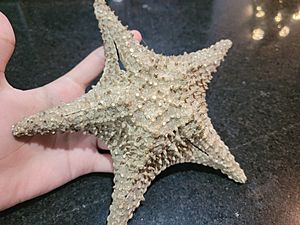
Starfish are important in science because they are closely related to animals with backbones, like humans. Scientists study them to learn about reproduction and how animals develop. Female starfish produce many eggs that are easy to study. These eggs can be kept in a special phase and then triggered to complete their development, which helps scientists understand cell division. Starfish eggs are great for this research because they are large, easy to handle, clear, simple to keep in sea water at room temperature, and they develop quickly. One species, Asterina pectinifera, is often used as a model organism because it's tough and easy to breed in the lab.
Another exciting area of research is how starfish can regrow lost body parts. Human adult stem cells can't change into many different types of cells, so understanding how starfish regrow and repair themselves could help us learn about human medicine.
Starfish also have a unique ability to push out foreign objects from their bodies. This makes it hard for scientists to tag them for tracking purposes.
Starfish in Stories and Art
An Aboriginal Australian story tells how some animals needed a canoe to cross the ocean. Whale had one but wouldn't share. So, Starfish kept Whale busy by telling stories and cleaning him, while the other animals secretly took the canoe. When Whale realized the trick, he beat Starfish, which is why Starfish looks ragged today.
In 1900, a scholar named Edward Tregear wrote about "The Creation Song," an ancient prayer from Hawaii. This song mentions "uncreated gods" like Kumulipo (Creation) and Poele, along with a coral insect, an earthworm, and the starfish.
Georg Eberhard Rumpf's 1705 book, The Ambonese Curiosity Cabinet, describes tropical starfish from around Ambon Island. He wrote that when sea stars "see thunder storms approaching, [they] grab hold of many small stones with their little legs, looking to... hold themselves down as if with anchors."
The word "Starfish" has also been used as a title for books, like novels by Peter Watts and Jennie Orbell. The Starfish and the Spider is a business book that uses the starfish's ability to regenerate as a way to explain how a decentralized organization can succeed.
In the popular Nickelodeon cartoon SpongeBob SquarePants, SpongeBob's best friend is a funny, dim-witted starfish named Patrick Star.
Starfish as Food
Starfish live all over the oceans, but people don't eat them very often. There's a good reason for this: many species have lots of bony plates, and their bodies can contain chemicals called saponins, which taste bad. Some even have tetrodotoxins, which are poisonous! Also, some starfish that eat shellfish can pass on a type of food poisoning.
Georg Eberhard Rumpf found that people in Indonesia didn't eat many starfish, except sometimes as bait for fish traps. But on one island, people would cut them up, squeeze out "black blood," and cook them with sour tamarind leaves. After a day or two, they would remove the outer skin and cook them in coconut milk. Starfish are sometimes eaten in China, Japan, and Micronesia.
Starfish as Souvenirs
Sadly, starfish are sometimes taken from their homes in the ocean and sold to tourists as souvenirs or decorations. For example, the Cushion sea star (Oreaster reticulatus), which is easy to find and brightly coloured, is often collected in the Caribbean. In the past, this species was very common, but collecting them for sale has greatly reduced their numbers. In the State of Florida, it's now illegal to collect O. reticulatus because it's an endangered species. But it's still sold in other places. A similar problem exists in the Indo-Pacific for species like Protoreaster nodosus.
Starfish in Industry and History
With their many arms, starfish are often used as a symbol for computer networks, companies, and computer programs. "Starfish" is also the name of a seabed imaging system and a company.
The name "Starfish" has been used many times in military history. Three ships of the Royal Navy were named HMS Starfish. During World War II, "Starfish sites" were large fake fires created at night to trick enemy planes into bombing empty areas instead of real British cities. Starfish Prime was a nuclear test carried out by the United States in 1962.
Images for kids
-
Pedicellariae and retracted papulae among the spines of Acanthaster planci
-
Three kinds of bilaterally symmetric starfish larvae (from left to right) scaphularia larva, bipinnaria larva, brachiolaria larva, all of Asterias sp. Painted by Ernst Haeckel
-
Sunflower seastar regenerating missing arms
-
Pisaster ochraceus consuming a mussel in central California
-
American herring gull feeding on a starfish
-
Starfish fossil, Riedaster reicheli, from the Plattenkalk Upper Jurassic limestone, Solnhofen
-
Ray fragment (oral surface; ambulacrum) of goniasterid asteroid; Zichor Formation (Coniacian, Upper Cretaceous), southern Israel.
-
Red-knobbed starfish, a member of Valvatida
See also
 In Spanish: Estrellas de mar para niños
In Spanish: Estrellas de mar para niños



